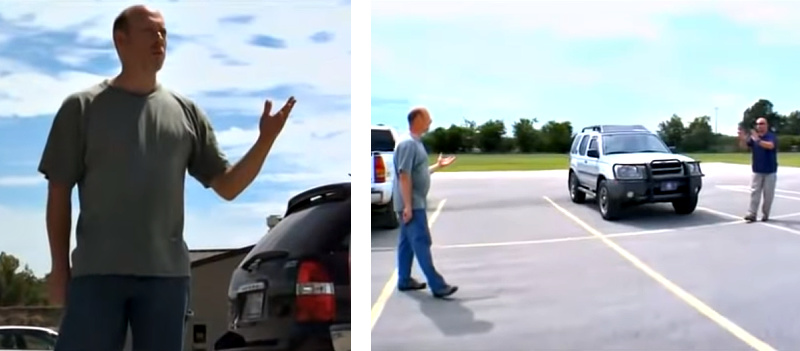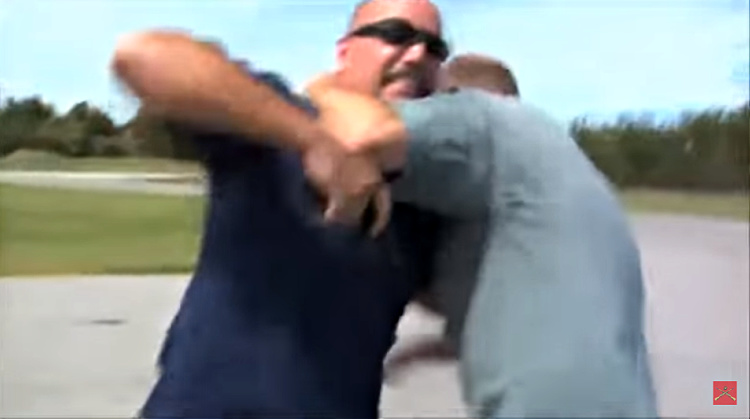Twenty-One feet. Sounds like a lot, doesn’t it? I’m here to tell you, it is not. That distance, 21 feet, might take a determined aggressor a bit less than 1.5 seconds to cover. When he’s armed with a knife, that time and distance become suddenly very crucial. Today we join Michael Bane as he discusses the Tueller Drill and how it relates to better protecting ourselves from harm.

Incidentally, 1.5 seconds is approximately the time it might take many people to access your firearm (assuming you’re even carrying one) with which to defend yourself. If you’re drawing from a police retention-type holster, which is meant to prevent gun grabs, the time to draw might be even longer.
Scenario 1
A man gets out of his vehicle in a parking lot. He’s probably going into a store to grab some items for that evening’s dinner after a stressful day at work. As he heads for the store, a stranger approaches him. Our guy notices that the stranger is holding a hand back behind his hip as though he’s concealing something.

Sensing that something isn’t right, our hero warns the man to stay back and orders him to stop, which he does not do. Instead, the stranger charges our guy, who begins drawing his handgun.

Just as our guy begins shooting, the stranger is upon him and begins stabbing him viciously, despite the fact that our hero is getting rounds off.

Michael Janich, noted defensive instructor, states that the “21 Foot Rule” has been misinterpreted. Many people believe that if someone is within 21 feet and armed with a knife, you’re justified in shooting them. Actually, there’s a bit more to it than that. Just because they’re armed, you cannot simply decide to shoot them.
Mike Seeklander explains: “People misinterpreted the drill to mean that, as long as I have 21 feet, I’ll have time to draw my weapon. But that’s in a situation where you have a perfect range set up, and you know that as soon as a whistle blows or a target faces, you’re going to draw and shoot.”
In other words, a Perfect World. Unfortunately, the world is very seldom perfect.“The second thing it doesn’t account for is stopping power.” He explains that the defender might get several shots off, as he did in the scenario. “But handgun calibers aren’t necessarily known for their stopping power.” We don’t know whether or not our bullets will have the effect of stopping the attacker before he can stab or shoot us. Handguns do suck at stopping people, that’s why the military carries rifles, as do Law Enforcement Special Teams.
Janich points out that the only reason Seeklander (in the scenario) was able to use the 21 feet is that he saw the pre-assault indicators (remember how the attacker held his hand back behind the hip as if concealing an object). Had he not seen that he would not have had a clue that he was about to be attacked. In the real world, many people who are attacked by armed individuals do not realize they are armed until well into the attack, if not afterward.
I’ll echo that sentiment. If we don’t know we’re being attacked, that precious 1.5 seconds is drastically eroded, maybe leaving us with no time to react.
If you are surprised by the attack, Janich points out, “It’s going to be you taking a gun to a knife fight.” He advocates adding empty-hand skills to your toolbox because that will raise your chances of survival.
Being able to deflect or redirect the attacker’s blade coming at you might buy you precious fractions of a second that you can use to save your life. It may allow you to avoid being sliced or stabbed and get shots off.
Combining empty-hand skills with firearms skills is crucial in many instances. Solely relying on a firearm is a bad idea because it limits the defender’s thinking and ability to survive. Be careful not to Task Fixate!
Second Scenario
In the second scenario, Seeklander gets a few shots off but the attacker does not stop. He reverts to parrying the knife stab away from his body and getting off the centerline. Then, he uses his handgun to strike the attacker in the side of the neck before delivering more shots.
Let me interject for a moment: I am not a big fan of using pistol strikes against an attacker if I can avoid it. Doing so opens up the possibility that the attacker could grab it. In such an instance, you find yourself fighting for control of that gun, which does nothing but add to your problems.
When Seeklander deflected the stab, he used the back of his forearm rather than the soft inside of the limb. Better to have the back of the arm cut than the soft underside (but best to not be cut at all).
Getting off that center line of attack is HUGE for survival! The attacker can run forward much faster than we can run backward! Janich notes, “The more mobility you add into the scenario, the higher your chances of survival.”
Third Scenario
In the third scenario, Seeklander runs around his truck and the attacker begins to follow, chasing him. Seeklander uses the truck as cover and an obstacle to gain an advantage over the attacker, who then becomes frustrated and breaks off the attack.

Will that work every time? Probably not. But if it allows us to prevail in the encounter and not have to shoot someone, that is golden!!! As a matter of fact, I used footwork to get myself out of the path of someone trying to stab me during an attack, and I’m convinced that it saved my life—or at least several pints of blood.
You may be thinking it’s not as cool to run away and not fire your weapon, but think of all the trouble you will save yourself by not having to pull that trigger. Let’s be real, if we ever have to shoot someone, a series of events will unfold:
- You will have to make a statement to the police (and possibly be taken into custody, no matter how right you are).
- You will have to hire an attorney (very expensive!).
- Your firearm will be taken into evidence.
- You will be sued civilly. Not maybe. For certain.
- You may be indicted for a criminal act and face a trial. More money and possibly the loss of your freedom.
- You might go to prison. Maybe you’re thinking, “But I was defending myself, I won’t go to prison.” Don’t kid yourself, there are many people in prison who don’t belong there. I worked in that system, I’ve seen it myself.
- At the very least, you will mentally have to deal with the aftermath of taking a life. And I don’t care how badass you think you might be, you will suffer some mental repercussions from such an event.
Opportunity
Marty Hayes of the Armed Citizens Legal Defense Network weighs in and notes that if we are attacked by a person with a knife or club, or even a group of people, the key element to consider is the element of Opportunity. “Can that person use the weapon against you, or can he use that weapon before you can defend yourself? You need to be able to articulate why you knew that he could close that distance within a heartbeat or so and stab you or hit you in the head with the contact weapon. Then, can you document the fact that you knew that? If it’s not documented, you probably don’t get to introduce that knowledge in court.”
He explains that the Tueller Drill is a standard in police academies and is working itself into civilian training as well. It is to your advantage to experience the Tueller Drill and have it documented in training.
Personally, I’d tend to agree with that premise a lot. We had a saying when I was in Law Enforcement: If it’s not on paper, it never happened.
Overall, this video covering the Tueller Drill does a nice job of teaching the various responses, and how some might be better than others during certain situations. It definitely gets a thumbs up!


